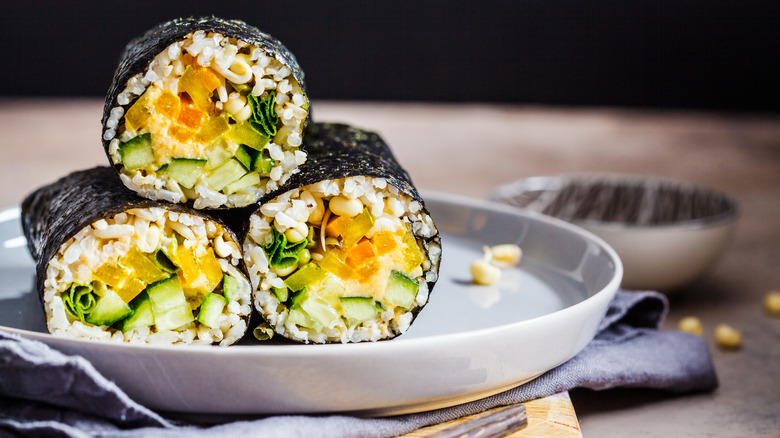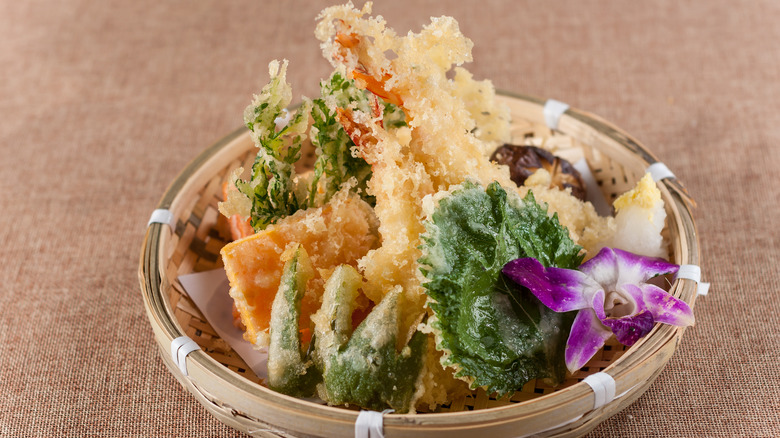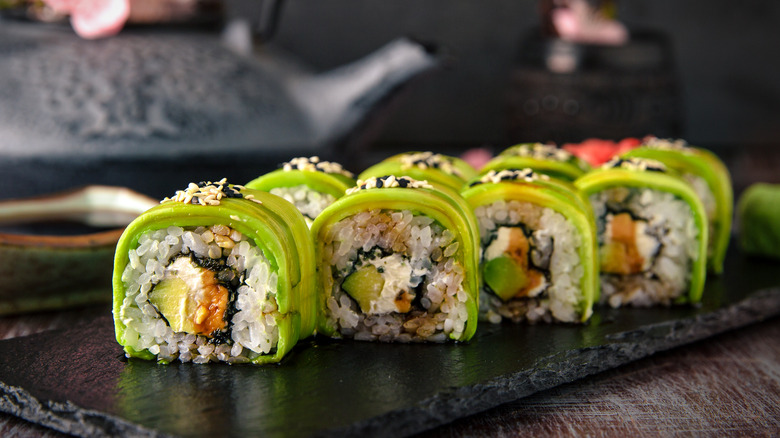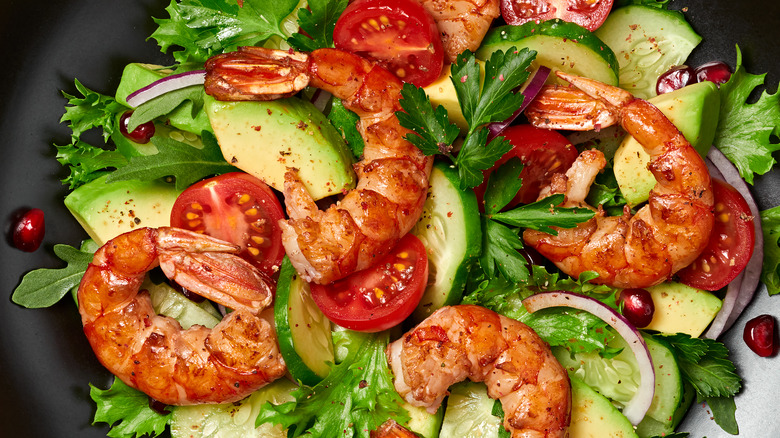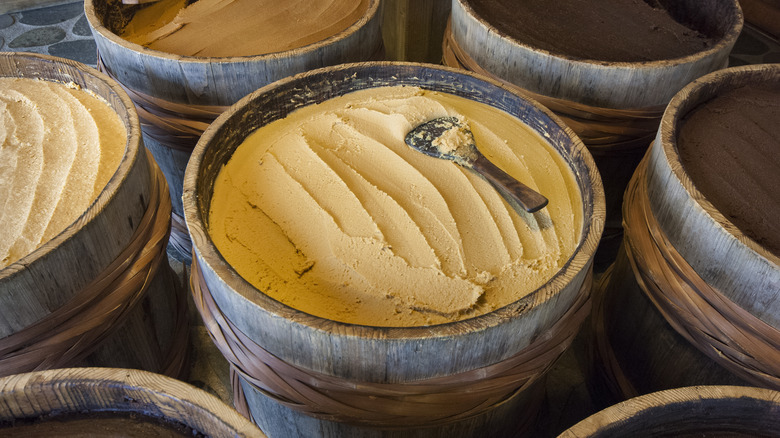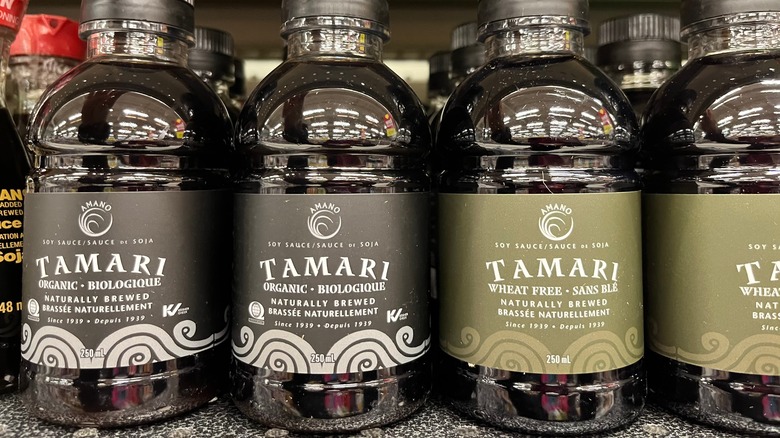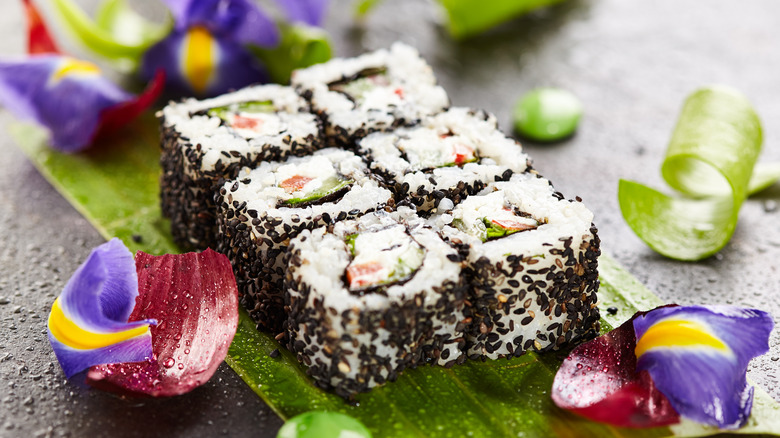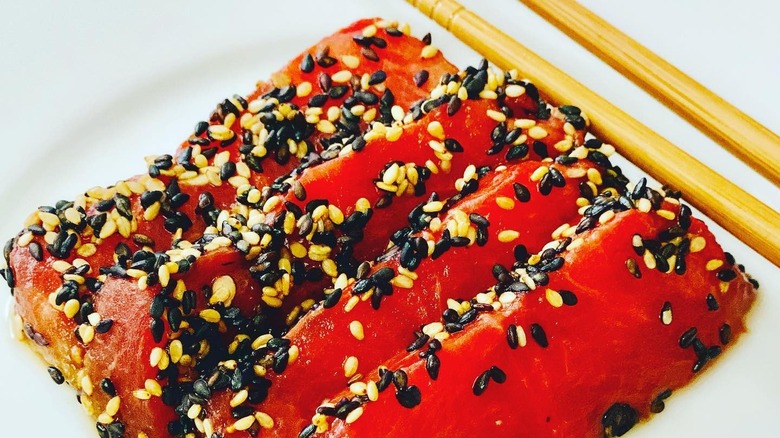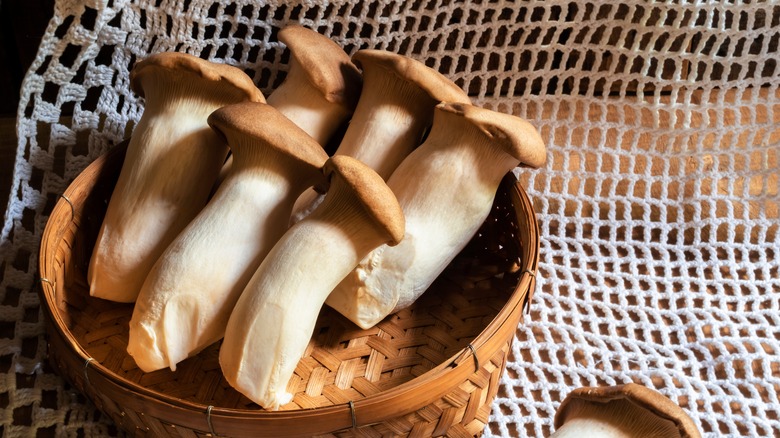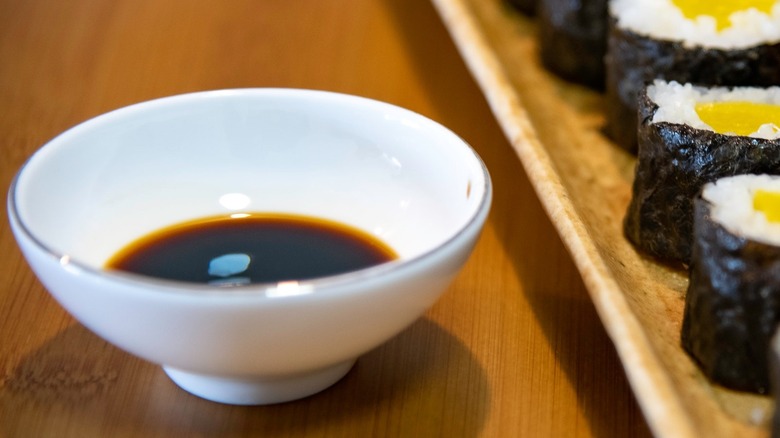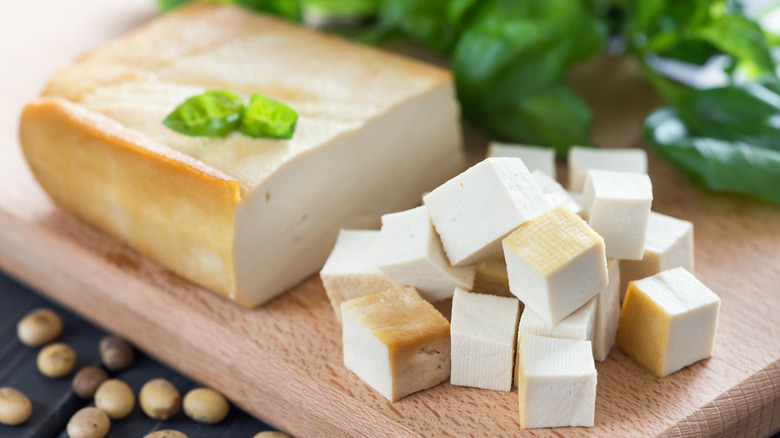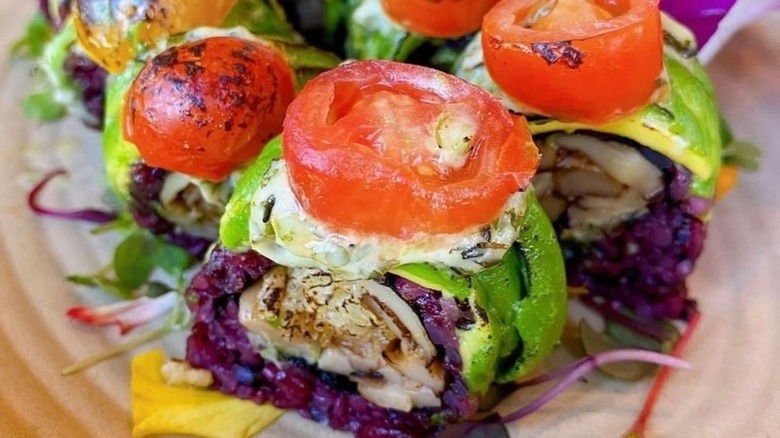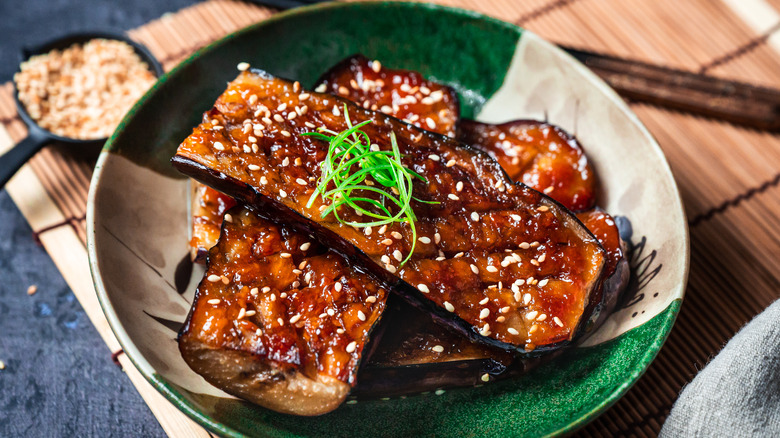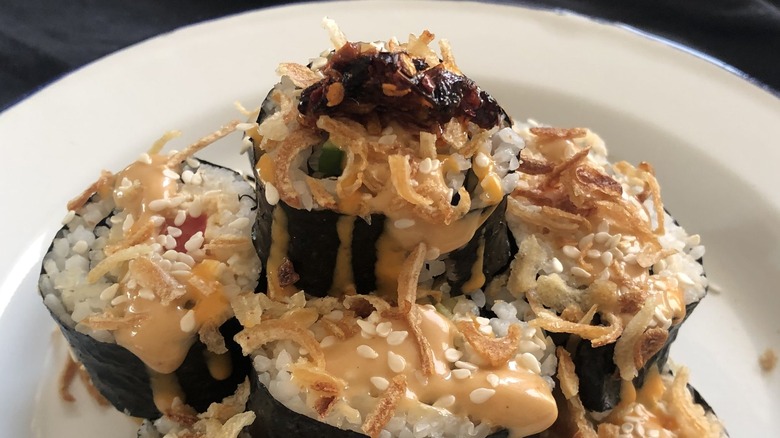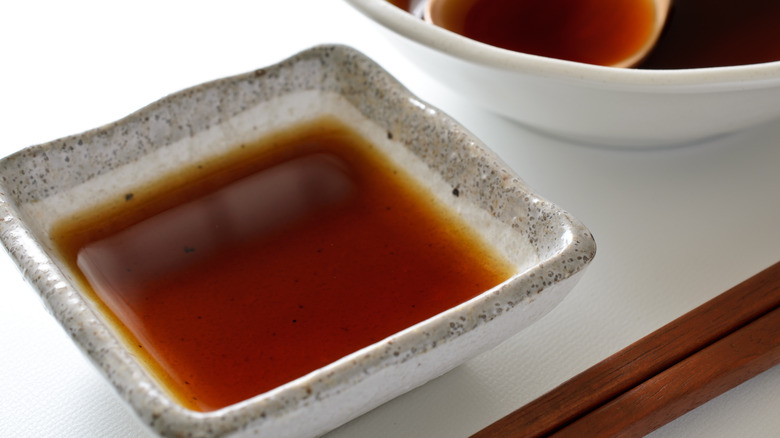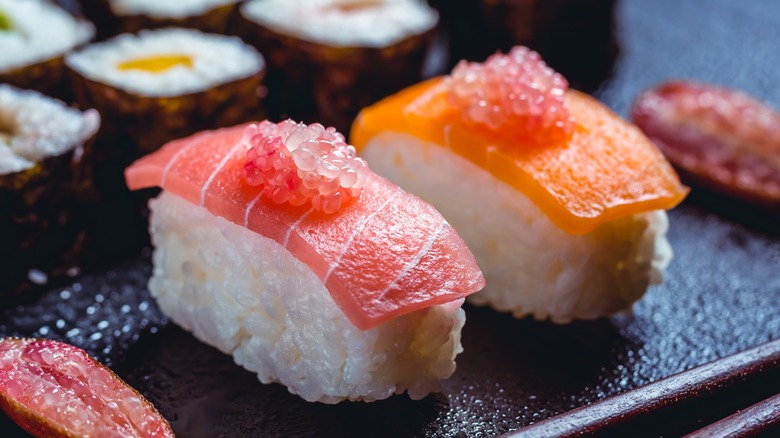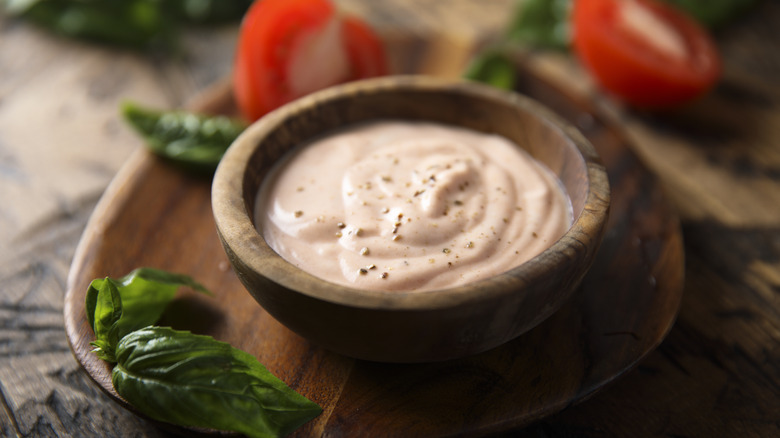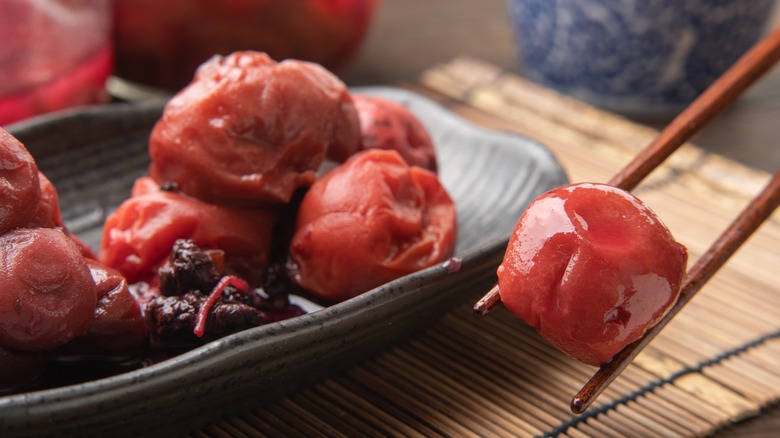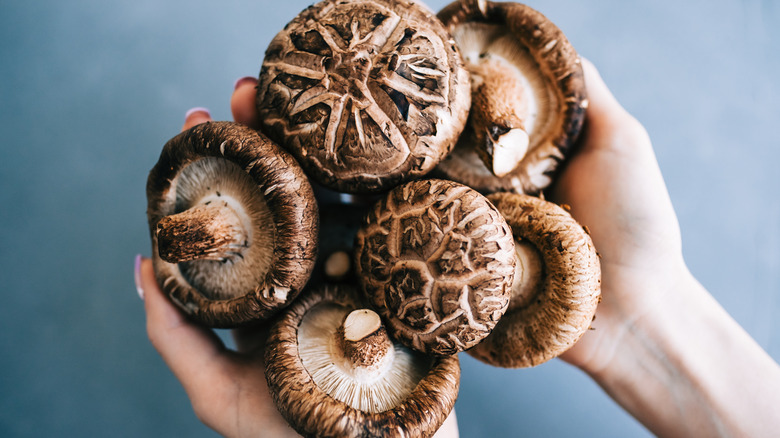19 Ingredients For Better Homemade Vegan Sushi
It might be time to rethink your assumptions about sushi. While the true origin of sushi remains a mystery, the iconic food has become synonymous with Japanese cuisine worldwide. Traditional sushi is a work of art; delicate knife skills and flawlessly balanced flavors of seasoned sushi rice (known as sumeshi), seaweed, and raw fish, form the basis of every type of sushi. But, what if we told all of you who are allergic to seafood, squeamish about raw fish, or concerned about sustainability, that plant-based sushi is on the rise — and it's just as good as the real thing?
Unsurprisingly, the secret lies in the ingredients. Think beyond cucumber, carrot, and avocado; we're talking about vegan caviar, crispy tempura, and marinated watermelon. Unsure which to pick? To help you select the top ingredients for better homemade vegan sushi, we've enlisted experts from two incredible plant-based restaurants with drool-worthy sushi menus.
First is Joel Jordan, the head chef of San Diego's first vegan Japanese restaurant, The Yasai by RakiRaki. Find its menu of ramen, bento boxes, maki rolls, and nigiri in two locations: Convoy and Little Italy. Adding to our wealth of knowledge is David Le, the executive chef behind Planta restaurants: A group of 11 restaurants scattered across the United States and Canada boasting an impressive menu of dumplings, small plates, noodles, rice, and sushi. By combining the two esteemed chefs' expert advice, you'll never make lackluster vegan sushi again. Get that sushi mat out, and let's get started.
Tempura vegetables
Your first instinct when making vegan sushi might be to reach for fresh vegetables — and you wouldn't be wrong. However, why stop there? Chef David Lee of Planta loves incorporating another classic Japanese dish — tempura — into basic rolls, transforming them into something extraordinary. Tempura refers to ingredients deep-fried in a light, airy, and unbelievably crispy batter. While many traditional tempura recipes call for egg, the most straightforward variation of delicate tempura batter is naturally vegan: Simply whisk all-purpose flour, cornstarch, and carbonated water together. The key is to keep it ice cold, so either keep the batter in an ice bath or add crushed ice to the mix.
Many vegetables are suitable for tempura, but for ease of rolling, cut them into uniform strips. Asparagus, carrot strips, long-stem broccoli, capsicum, sweet potatoes, squash, zucchini, green beans, and eggplant will each add a distinctive taste and texture, so mix and match accordingly.
Avocado
Even though avocado is widely associated with sushi in the U.S., it's a moderately modern addition. The avocado fruit is wholly foreign to Japan and only arrived on its shores, imported from Mexico, sometime between the 1960s-70s. Due to this, it never really caught on as a sushi ingredient. That all changed in California when a Japanese chef noticed that avocado possessed the quintessential fatty and creamy texture of exquisite sashimi and began to use it frequently due to its abundance. Soon, this happy discovery led the way to the now-famous California roll, caterpillar roll, and avocado roll. Moreover, it's for this very reason that avocado is a requisite for homemade vegan sushi; it's widely available, malleable enough to drape over sushi rolls, and has a delectable mouthfeel.
Vegan shrimp
Owing to multiple incredibly pioneering brands, it's now possible to almost completely recreate seafood-based sushi with plant-based ingredients — to the extent that it looks and tastes no different. Don't believe us? The Yasai restaurants offer several sushi rolls loaded with panko-breaded shrimp, frequently mistaken for the real deal by unsuspecting customers. It shouldn't come as a surprise, then, that Chef Jordan reported that vegan seafood substitutes are one of his favorite ingredients, noting how easy it is to incorporate them into dishes.
Handling plant-based substitutes might seem intimidating initially, but you can treat vegan shrimp the same as any other protein. To make sushi, we suggest coating it with crispy panko breadcrumbs and deep-frying it before rolling the tender, meaty shrimp with creamy avocado, and refreshing cucumber.
Miso paste
When we spoke to the co-owner and executive chef of Planta, Lee emphasized the importance of employing seasonings that will highlight and accentuate the natural flavors of other ingredients. Foremost on his list is miso, a deeply savory, salty, toasted, and slightly sweet paste. The complex, layered notes in different types of miso paste derive from its processing — specifically, two-step fermentation.
First, rice (or another grain) is mixed with a kōji culture starter and left to ferment for several days. Secondly, cooked soybeans are mashed into a paste, added to the rice, and allowed to age. Because the fermented paste has such an assertive flavor, it's vital to know how to use miso. We suggest using it to accent other ingredients: For example, brush eggplant with sweet miso, sauté mushrooms in vegan butter infused with miso and garlic, or glaze the sushi rolls in a compound of miso with sriracha or vegan mayo.
Tamari
Welcome to the less famous relative of soy sauce: tamari. Often described as "Japanese soy sauce," while the two condiments initially look very similar, the difference between soy sauce and tamari lies in the ingredients. Whereas soy sauce is made by fermenting chickpeas and roasted wheat, manufacturers produce tamari as a byproduct of miso production, exclusively with fermented soybeans. This slight distinction makes all the difference to flavor, resulting in a deeper, heavier, and more velvety consistency. Coincidently, the distinction makes tamari a gluten-free alternative to soy sauce.
But, how can tamari be used to create better homemade sushi? Chef Lee suggests tamari is vital to achieving umami, a distinctively savory piquancy usually only found in meat. It can be used in dipping sauces or marinations, moderately or liberally, and in conjunction with soy sauce or alone.
Vegan cream cheese
Sushi may be a legendary Japanese dish, but the innovative sushi chefs who brought the techniques to the U.S. have carved a unique space for themselves. Among the countless variations of sushi created in America are Philadelphia rolls — uramaki sushi (meaning inside out) is made with smoked salmon, cream cheese, and crisp cucumber. Philadelphia rolls are essentially bagels in sushi form, but, surprisingly, it works.
While smoked salmon and cucumber are widespread in sushi culture, the true outlier here is cream cheese, a polarising ingredient that, if used correctly, can heighten the experience of biting into a sushi roll. Of course, traditional cream cheese isn't vegan-friendly, but luckily, there's no reason to skip it; top vegan brands such as Daiya, Miyoko's, Violife, and Kite Hill offer cream cheese substitutes (even Philadelphia makes plant-based cream cheese).
While Philadelphia rolls seem the obvious choice, avoid limiting yourself. The creamy whipped texture is an excellent way to juxtapose chewy sushi rice, crunchy vegetables, panko-coated vegan shrimp, or crispy tempura. To avoid the frequent mistake of watering down the flavor of other ingredients in the sushi, pair cream cheese with intensely flavored ingredients like spicy tempeh or miso-fried mushrooms.
Watermelon
Watermelon in sushi? We understand your hesitancy but hear us out. As strange as it may sound, with some cookery magic, it's possible to transform the beloved summer fruit into something that resembles tuna. Of course, you won't be able to achieve this effect by simply slicing raw melon and placing it on top of your sushi. We need to infuse some flavor into the sweet flesh of the melon.
The best way to create a marinade full of umami uses tamari, vegan fish sauce, nori flakes, sesame oil, ginger, and vinegar. Next, we need to transform the texture of the watermelon by baking it; this reduces the water content and alters the crisp, moist texture into something juicy, fleshy, firm, and fatty.
For the ultimate wow factor, present the watermelon cut into delicate slices and layered on top of the nigiri. The bright pink flesh is sure to make anyone do a double take in amazement. Alternatively, cut the watermelon into thick slabs and roll it along with fillings of your choice to make a classic roll.
Marinated king oyster mushrooms
If there's one mushroom with a reputation for being meaty, it's the king oyster mushroom, which is known as eringi in Japan. Native to the Mediterranean, king oyster mushrooms have picked up popularity in vegan circles because the meaty flavor of the mushroom is said to taste like chicken. Admittedly, chicken is a rarity in sushi, but the thick stems, full-bodied texture, and abundant umami make king oyster mushrooms suitable for transforming into any number of avatars.
For example, the meaty ends can be sautéed with seaweed, lemon juice, and paprika (for that juicy pink color). Conversely, scoring the mushroom and letting it rest in a concentrated marinade full of salty, umami flavors before torching or grilling it, will result in a beautiful topping for nigiri sushi.
Eel sauce
Eel sauce, vegan? Although you may be skeptical, the name of this condiment is a misnomer, as most brands sold and used in the U.S. don't contain any eel. So, where did the name come from? Like barbecue sauce, eel sauce takes its name from the dish it typically accompanies — grilled freshwater eel. Made by reducing umami-rich soy sauce, mirin, and sugar, the thick, unctuous, and glossy dressing boasts a well-balanced sweet-salty flavor that perfectly complements seafood, making it a popular choice for drizzling over seafood dishes, including sushi.
Homemade eel sauce is easy to whip up in a rush, but, alternatively, if you prefer not to make it yourself, you can always find numerous options at Asian grocery stores. Once you get your hands on some, we recommend serving a bowl alongside your sushi so you can brush it over the rolls just before eating. Because the flavors of the sticky condiment traditionally compliment seafood, pair it with sushi made with vegan shrimp or salmon — it's so tempting we'll be surprised if you're not left licking it off the plate!
Smoked tofu
Tofu is one of the ancient cornerstones of vegan cuisine. In Japan, monks have followed a strict vegetarian diet for centuries, creating many meat-free dishes that employ tofu as the main protein. Seemingly neverending classifications of tofu — silken, soft, firm, extra firm, puffed — can each add something special to sushi. However, an excellent place to start is the intricate flavor profile of firm smoked tofu, which adds a subtle depth and rounds most vegetables. Smoked tofu can be fried until it develops crispy edges and a chewy interior, marinated with umami-rich sauces, or kept mild and soft depending on the textural play you wish to achieve. Either way, cut it into chunky strips and layer up with vegetables.
Tomato
As the saying goes, "when there's a will, there's a way," and vegan chefs haven't allowed any food restrictions to limit their inventive dishes. For example, did you ever imagine that fruit could pose as realistic vegan tuna? Once boiled, skinned, sliced, and marinated with salty soy, an ingredient we likely all have lurking in our kitchens — tomatoes — metamorphizes into vibrant, firm "sashimi."
To complete the transformation, get gastronomical and follow expert chef Lee's direction by torching the tomato. Gentle exposure to a raw flame will char the edges, a technique that develops a pleasantly potent woody, smoky after-taste and is a known flavor enhancer. Instead of using the tomato atop sushi rolls, you can also dice it and add it to the filling, thereby delivering a juicy burst of flavor to each bite.
Mirin
At first glance, it doesn't seem like wine would have anything to do with sushi. Cooking with mirin, a sweet fermented rice wine, is a mainstay in any traditional Japanese kitchen. Similarly to many other Japanese foods, such as tamari and miso, mirin is fermented: First, mochi rice is blended with kōji and alcohol made from sweet potatoes before being left to ferment for around two months. Only some chefs opt for real mirin; others prefer cheaper, alcohol-free alternatives called "mirin-like condiments."
Now that we understand what mirin is, we need to tackle how to cook sushi with it. Co-founder and executive chef David Lee divulged that mirin is vital for achieving the balanced, umami-laced sensation found in Planta's sushi. Notably, mirin offers a distinctively high-sugar content, meaning it's crucial for creating caramelized sauces, marinades, and glazes.
Glazed eggplant
While the vegan diet can seem limiting to outsiders, in reality, it's anything but. When we spoke to Joel Jordan, head chef of The Yasai, he was tremendously passionate about vegan cuisine. "Every ingredient has the potential to be manipulated to elevate flavor profiles," Jordan says. "It's that limitless spectrum of potential that pulls me in so much about creating vegan-based sushi."
Eggplant is no exception; when cooked, it has a meltingly tender, creamy, and fleshy texture reminiscent of eel. Glaze it with a sticky, sweet, umami, salty concoction of mirin, sake, soy sauce, and a dash of extra sugar, and lay the eggplant on top of sushi nigiri. Whether you're a vegan or just looking to try something new, glazed eggplant on sushi is worth adding to your culinary repertoire.
Vegan crabmeat
Since its inception in the late-20th century, California rolls have dominated the North American sushi culture. Despite varying accounts of its origin and creator, everyone agrees that the classic sushi roll was initially produced to address the public's aversion to raw seafood. Consequently, chefs began using imitation crab, known as surimi. Although this derivative isn't vegetarian, much less vegan, home cooks can easily make their own "imitation crab" with entirely plant-based ingredients.
Chewy and shredded artichoke hearts, fleshy hearts of palm, or shredded extra-firm tofu each provide a textural basis, but the real magic happens in the seasoning. Grab your ingredient of choice and combine it with plenty of vegan mayonnaise, zesty lemon juice, dijon mustard, and salt, within seconds, you have a creamy, tender crab alternative. There's nothing crabby here, only joy — we promise.
Ponzu sauce
Can't decide what sauces to use for your next vegan sushi dine-in? We've got you covered. An often overshadowed element of sushi platters, a drizzle of sauce can be the difference between exceptional and mediocre homemade vegan sushi. Ponzu sauce, a delicate yet acidic, citrusy, and warm dressing, is anything but mediocre. While some variants aren't vegan — we're looking at you, ponzu sauce with added katsuobushi flakes (dried fish chips) — the basic version is made from a concoction of soy sauce, mirin, tangy rice vinegar, sugar, and refreshing lemon juice.
The lead chef of The Yasai has a sweet spot for ponzu. Jordan says it's especially delightful paired with sushi during hot summer months and went on to reassure us that katsuobushi flakes aren't needed, as citrus should be the dominating taste.
Seaweed Caviar
Did you know that caviar can be made from seaweed? Whereas traditional caviar, although an expensive delicacy, is made from the admittedly rather unappetizing salt-cured roe, which are fish eggs, seaweed-based caviar is a nutritious and sustainable alternative with a convincing appearance, salty flavor, and a firm, smooth texture. While it can be hard to get your hands on this luxury vegan item, those interested in dabbling with molecular gastronomy can use the plant-based agar-agar, kelp, and spherification to make them at home.
Treat vegan caviar just like any other — except there's no need to be stingy because it's not costly. It adds an impressive pop of color carefully balanced on top of individual rolls, or, if you really want to make a statement, roll inside-out uramaki sushi in the caviar to cover it completely.
Vegan aioli
It's still a common misconception to think that vegan substitutes are sometimes limited or less satisfactory than their non-vegan counterparts. You may be used to run-of-the-mill, store-bought condiments such as mayonnaise or aioli. On the contrary, vegan aioli is a balanced substitute that maintains the flavor and richness of a creamy, savory dip. Head chef Jordan explains that vegan aioli can be made with vegan mayo or thickened with corn starch. You can play with the flavors by adding a hint of garlic, sesame oil, and sriracha for an adventurous punch and add citrus (or ponzu sauce) for a tangy, piquant kick. The smooth textured aioli serves as the perfect addition to vegan sushi with crispy elements, and we recommend you give this try.
Pickled plum and shisho
Pickled fruits are an integral part of Asian cuisine, particularly Japanese dishes. One such example is ume, small and intensely sour Japanese plums that are a relative of the more widespread apricot. Once pickled in salt, ume becomes umeboshi — briny, tangy, and fruity. Strikingly, the traditional red shiso (a popular herb related to mint) added during the fermentation process lends its color to the plums, dying them a fiery, bright pink.
The pickles aren't used directly in the sushi; instead, one or two pickled plums are ground into a smooth paste, then mixed with oil and fresh green shiso leaves. The paste can be spread between the nori-rice layer or added in a small dot on top of the finished roll to bring a touch of lively acidity to your sushi.
Fried shiitake mushrooms
Mushrooms are a divisive ingredient, but their meaty texture and rich, earthy, umami flavor make them an indispensable staple for vegan diets. For this reason, culinarians have been using mushrooms as a plant-based meat alternative for decades. Now, the average home cook is steadily introducing a greater variety of mushrooms beyond the familiar button or portobello to their meals — including Japanese fungi like matsutake, maitake, enoki, shiitake, and shimeji.
Not sure which is the best pick for your sushi? When we spoke to the regional manager and head chef of The Yasai, Joel Jordan, he told us that thicker, more robust mushrooms are best for marinating and frying. Chef Jordan explicitly recommends shiitake mushrooms, indicating that "when fried with vegan miso paste, they make an excellent addition to any roll." We agree. Although unassuming in appearance, the robust smoky, and buttery flavor of shiitake is unmissable.
Static Media owns and operates Tasting Table and Mashed.
